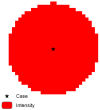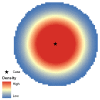Density estimation and adaptive bandwidths: a primer for public health practitioners
- PMID: 20653969
- PMCID: PMC2920858
- DOI: 10.1186/1476-072X-9-39
Density estimation and adaptive bandwidths: a primer for public health practitioners
Abstract
Background: Geographic information systems have advanced the ability to both visualize and analyze point data. While point-based maps can be aggregated to differing areal units and examined at varying resolutions, two problems arise 1) the modifiable areal unit problem and 2) any corresponding data must be available both at the scale of analysis and in the same geographic units. Kernel density estimation (KDE) produces a smooth, continuous surface where each location in the study area is assigned a density value irrespective of arbitrary administrative boundaries. We review KDE, and introduce the technique of utilizing an adaptive bandwidth to address the underlying heterogeneous population distributions common in public health research.
Results: The density of occurrences should not be interpreted without knowledge of the underlying population distribution. When the effect of the background population is successfully accounted for, differences in point patterns in similar population areas are more discernible; it is generally these variations that are of most interest. A static bandwidth KDE does not distinguish the spatial extents of interesting areas, nor does it expose patterns above and beyond those due to geographic variations in the density of the underlying population. An adaptive bandwidth method uses background population data to calculate a kernel of varying size for each individual case. This limits the influence of a single case to a small spatial extent where the population density is high as the bandwidth is small. If the primary concern is distance, a static bandwidth is preferable because it may be better to define the "neighborhood" or exposure risk based on distance. If the primary concern is differences in exposure across the population, a bandwidth adapting to the population is preferred.
Conclusions: Kernel density estimation is a useful way to consider exposure at any point within a spatial frame, irrespective of administrative boundaries. Utilization of an adaptive bandwidth may be particularly useful in comparing two similarly populated areas when studying health disparities or other issues comparing populations in public health.
Figures









Similar articles
-
Folic acid supplementation and malaria susceptibility and severity among people taking antifolate antimalarial drugs in endemic areas.Cochrane Database Syst Rev. 2022 Feb 1;2(2022):CD014217. doi: 10.1002/14651858.CD014217. Cochrane Database Syst Rev. 2022. PMID: 36321557 Free PMC article.
-
Comparing adaptive and fixed bandwidth-based kernel density estimates in spatial cancer epidemiology.Int J Health Geogr. 2015 Mar 31;14:15. doi: 10.1186/s12942-015-0005-9. Int J Health Geogr. 2015. PMID: 25889018 Free PMC article.
-
Geostatistical analysis of disease data: accounting for spatial support and population density in the isopleth mapping of cancer mortality risk using area-to-point Poisson kriging.Int J Health Geogr. 2006 Nov 30;5:52. doi: 10.1186/1476-072X-5-52. Int J Health Geogr. 2006. PMID: 17137504 Free PMC article.
-
Evaluation of threshold selection methods for adaptive kernel density estimation in disease mapping.Int J Health Geogr. 2018 May 8;17(1):10. doi: 10.1186/s12942-018-0129-9. Int J Health Geogr. 2018. PMID: 29739415 Free PMC article.
-
Tutorial on kernel estimation of continuous spatial and spatiotemporal relative risk.Stat Med. 2018 Mar 30;37(7):1191-1221. doi: 10.1002/sim.7577. Epub 2017 Dec 11. Stat Med. 2018. PMID: 29226352 Review.
Cited by
-
Characterizing physical activity and food urban environments: a GIS-based multicomponent proposal.Int J Health Geogr. 2016 Oct 4;15(1):35. doi: 10.1186/s12942-016-0065-5. Int J Health Geogr. 2016. PMID: 27716312 Free PMC article.
-
Cattle transhumance and agropastoral nomadic herding practices in Central Cameroon.BMC Vet Res. 2018 Jul 3;14(1):214. doi: 10.1186/s12917-018-1515-z. BMC Vet Res. 2018. PMID: 29970084 Free PMC article.
-
Using Smartphone Survey and GPS Data to Inform Smoking Cessation Intervention Delivery: Case Study.JMIR Mhealth Uhealth. 2023 Jun 16;11:e43990. doi: 10.2196/43990. JMIR Mhealth Uhealth. 2023. PMID: 37327031 Free PMC article.
-
Tobacco outlet density and converted versus native non-daily cigarette use in a national US sample.Tob Control. 2017 Jan;26(1):85-91. doi: 10.1136/tobaccocontrol-2015-052487. Epub 2016 Mar 11. Tob Control. 2017. PMID: 26969172 Free PMC article.
-
"Contextualizing Context": Reconciling Environmental Exposures, Social Networks, and Location Preferences in Health Research.Curr Environ Health Rep. 2017 Mar;4(1):51-60. doi: 10.1007/s40572-017-0121-8. Curr Environ Health Rep. 2017. PMID: 28188604 Review.
References
-
- Snow J. On the mode of communication of cholera. 2. London,: J. Churchill; 1855.
-
- Tracking Swine Flu Cases Worldwide. The New York Times. 2009. http://www.nytimes.com/interactive/2009/04/27/us/20090427-flu-update-gra...
Publication types
MeSH terms
Grants and funding
LinkOut - more resources
Full Text Sources

